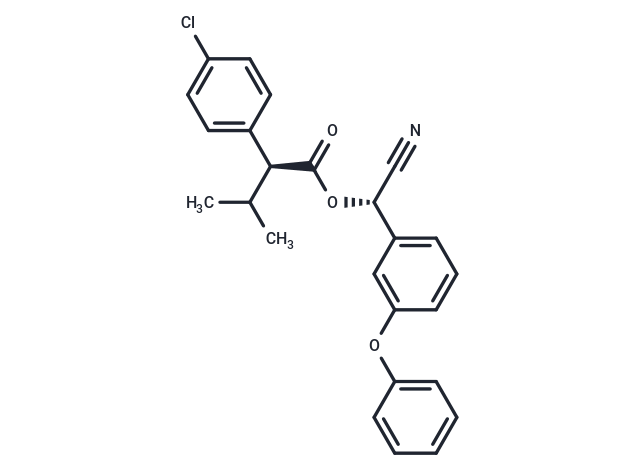Shopping Cart
- Remove All
 Your shopping cart is currently empty
Your shopping cart is currently empty
Esfenvalerate (Asana) is a widely used insecticide.

| Pack Size | Price | Availability | Quantity |
|---|---|---|---|
| 50 mg | $41 | In Stock | |
| 100 mg | $66 | In Stock | |
| 1 mL x 10 mM (in DMSO) | $50 | In Stock |
| Description | Esfenvalerate (Asana) is a widely used insecticide. |
| In vitro | Esfenvalerate (S,S-fenvalerate) and its main metabolites [3-phenoxybenzaldehyde (PBAld), 3-phenoxybenzoic acid (PBAc), 3-phenoxybenzyl alcohol (PBAlc), and 2-(4-chlorophenyl)-3-methylbutyric acid (CLAc)] were quantitatively analyzed by a validated method in triplicate experiments. All the strains (Penicillium raistrickii CBMAI 931, Aspergillus sydowii CBMAI 935, Cladosporium sp. CBMAI 1237, Microsphaeropsis sp. CBMAI 1675, Acremonium sp. CBMAI 1676, Westerdykella sp. CBMAI 1679, and Cladosporium sp. CBMAI 1678) were able to degrade esfenvalerate, however, with different efficiencies. Initially, 100 mg L(-1) esfenvalerate (Sumidan 150SC) was added to each culture in 3 % malt liquid medium. Residual esfenvalerate (64.8-95.2 mg L(-1)) and the concentrations of PBAc (0.5-7.4 mg L(-1)), ClAc (0.1-7.5 mg L(-1)), and PBAlc (0.2 mg L(-1)) were determined after 14 days. In experiments after 7, 14, 21, and 28 days of biodegradation with the three most efficient strains, increasing concentrations of the toxic compounds PBAc (2.7-16.6 mg L(-1), after 28 days) and CLAc (6.6-13.4 mg L(-1), after 28 days) were observed. A biodegradation pathway was proposed, based on HPLC-ToF results. The biodegradation pathway includes PBAld, PBAc, PBAlc, ClAc, 2-hydroxy-2-(3-phenoxyphenyl)acetonitrile, 3-(hydroxyphenoxy)benzoic acid, and methyl 3-phenoxy benzoate. Marine-derived fungi were able to biodegrade esfenvalerate in a commercial formulation and showed their potential for future bioremediation studies in contaminated soils and water bodies. |
| In vivo | Fenvalerate (FV), an extensively used synthetic pyrethroid, is a typical chiral pesticide. The most insecticidally active enantiomer of FV, esfenvalerate (ESFV), also has been marketed and widely used. In this study, the toxicological sensitivity and bioaccumulation of FV and ESFV in earthworms were assessed. The results showed that FV was less toxic than ESFV, but more accumulated in earthworms. ESFV was at least 4 times more toxic to earthworms than FV according to the filter paper contact toxicity test and the artificial soil test. Enantiospecific induction in oxidative stress was observed in earthworms exposed to FV and ESFV. The bioaccumulation of FV and ESFV in earthworm tissues was also enantioselective, preferentially accumulating FV. The uptake of ESFV by earthworms was lower than that of FV, so that the biota to soil accumulation factor (BSAF) value of ESFV was lower than that of FV. Our findings suggest that the enantioselective toxicity and bioaccumulation of chiral pesticides should be considered for evaluating ecological risks of these compounds to non-target organisms[1]. |
| Synonyms | Halmark, Asana, A alpha |
| Molecular Weight | 419.9 |
| Formula | C25H22ClNO3 |
| Cas No. | 66230-04-4 |
| Smiles | CC(C)[C@H](C(=O)O[C@H](C#N)c1cccc(Oc2ccccc2)c1)c1ccc(Cl)cc1 |
| Relative Density. | 1.21 g/cm3 |
| Color | Yellow |
| Appearance | Solid |
| Storage | Powder: -20°C for 3 years | In solvent: -80°C for 1 year | Shipping with blue ice/Shipping at ambient temperature. | |||||||||||||||||||||||||||||||||||
| Solubility Information | DMSO: 100 mg/mL (238.15 mM), Sonication is recommended. | |||||||||||||||||||||||||||||||||||
Solution Preparation Table | ||||||||||||||||||||||||||||||||||||
DMSO
| ||||||||||||||||||||||||||||||||||||

Copyright © 2015-2025 TargetMol Chemicals Inc. All Rights Reserved.